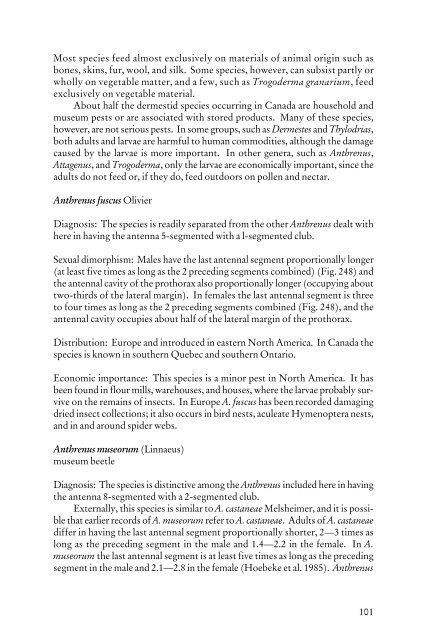Beetles Identification Guide
Beetles Identification Guide
Beetles Identification Guide
You also want an ePaper? Increase the reach of your titles
YUMPU automatically turns print PDFs into web optimized ePapers that Google loves.
Most species feed almost exclusively on materials of animal origin such as<br />
bones, skins, fur, wool, and silk. Some species, however, can subsist partly or<br />
wholly on vegetable matter, and a few, such as Trogoderma granarium, feed<br />
exclusively on vegetable material.<br />
About half the dermestid species occurring in Canada are household and<br />
museum pests or are associated with stored products. Many of these species,<br />
however, are not serious pests. In some groups, such as Dermestes and Thylodrias,<br />
both adults and larvae are harmful to human commodities, although the damage<br />
caused by the larvae is more important. In other genera, such as Anthrenus,<br />
Attagenus, and Trogoderma, only the larvae are economically important, since the<br />
adults do not feed or, if they do, feed outdoors on pollen and nectar.<br />
Anthrenus fuscus Olivier<br />
Diagnosis: The species is readily separated from the other Anthrenus dealt with<br />
here in having the antenna 5-segmented with a l-segmented club.<br />
Sexual dimorphism: Males have the last antennal segment proportionally longer<br />
(at least five times as long as the 2 preceding segments combined) (Fig. 248) and<br />
the antennal cavity of the prothorax also proportionally longer (occupying about<br />
two-thirds of the lateral margin). In females the last antennal segment is three<br />
to four times as long as the 2 preceding segments combined (Fig. 248), and the<br />
antennal cavity occupies about half of the lateral margin of the prothorax.<br />
Distribution: Europe and introduced in eastern North America. In Canada the<br />
species is known in southern Quebec and southern Ontario.<br />
Economic importance: This species is a minor pest in North America. It has<br />
been found in flour mills, warehouses, and houses, where the larvae probably survive<br />
on the remains of insects. In Europe A. fuscus has been recorded damaging<br />
dried insect collections; it also occurs in bird nests, aculeate Hymenoptera nests,<br />
and in and around spider webs.<br />
Anthrenus museorum (Linnaeus)<br />
museum beetle<br />
Diagnosis: The species is distinctive among the Anthrenus included here in having<br />
the antenna 8-segmented with a 2-segmented club.<br />
Externally, this species is similar to A. castaneae Melsheimer, and it is possible<br />
that earlier records of A. museorum refer to A. castaneae. Adults of A. castaneae<br />
differ in having the last antennal segment proportionally shorter, 2—3 times as<br />
long as the preceding segment in the male and 1.4—2.2 in the female. In A.<br />
museorum the last antennal segment is at least five times as long as the preceding<br />
segment in the male and 2.1—2.8 in the female (Hoebeke et al. 1985). Anthrenus<br />
101
















